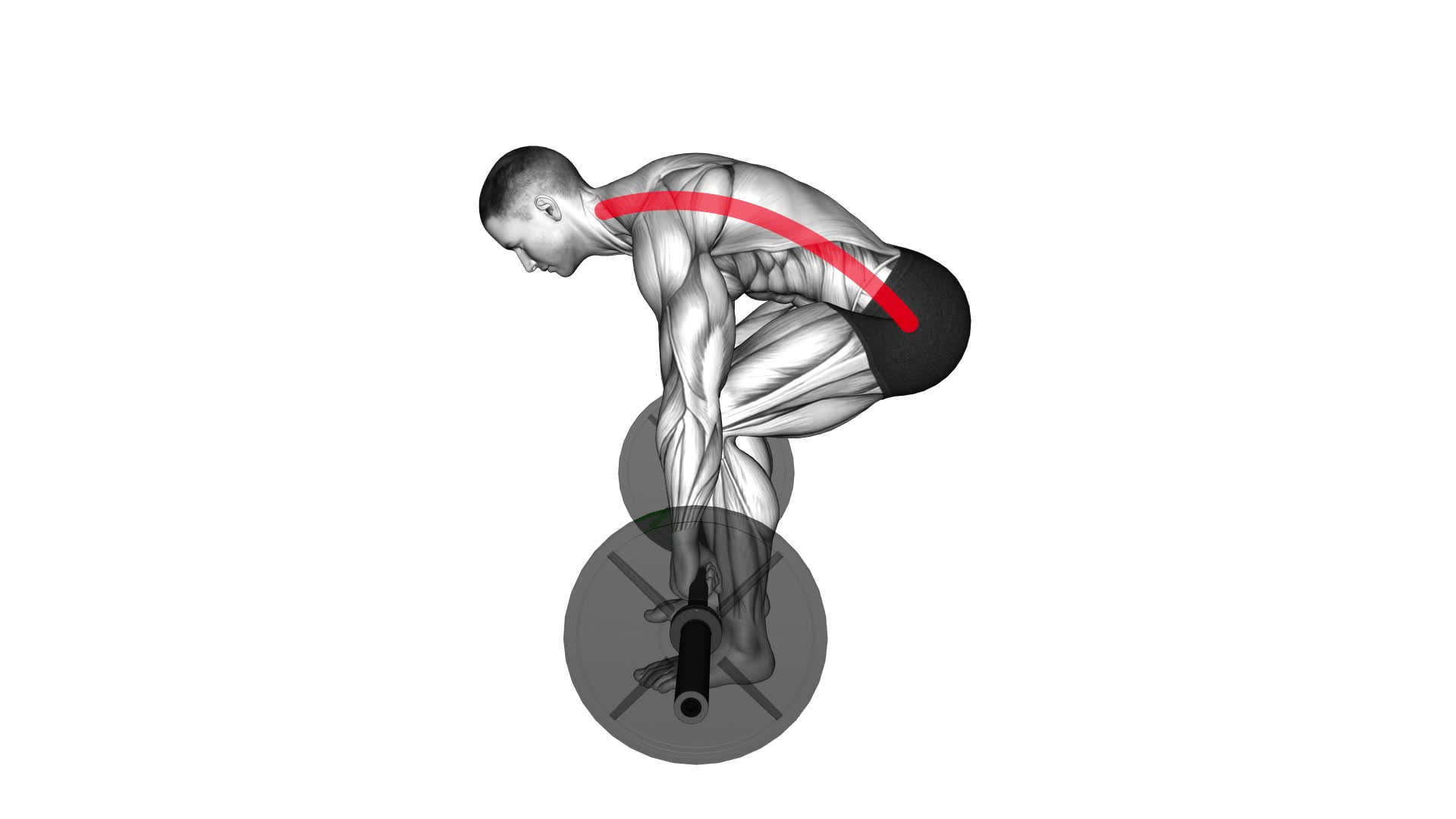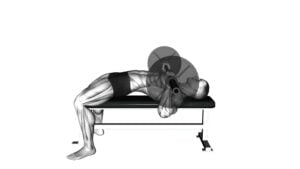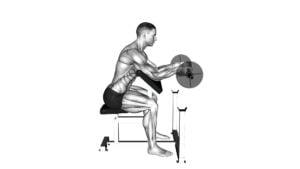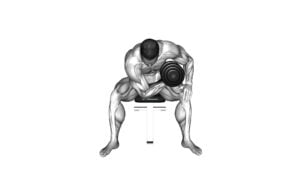Deadlift – Back (WRONG RIGHT) – Video Exercise Guide & Tips

Are you struggling with your deadlift technique? Don't worry, we've got you covered!
Watch This Exercise Video
In this article, we'll guide you through the common mistakes to avoid and show you the proper technique for a killer deadlift.
By executing this exercise correctly, you'll experience amazing benefits such as increased strength and improved posture.
Plus, we've included a helpful video exercise guide and some valuable tips to help you boost your deadlift performance.
Let's get started!
Key Takeaways
- Proper deadlift form includes maintaining a neutral spine, engaging core muscles, and driving through the heels.
- Common mistakes to avoid during deadlifts include rounding the back, improper setup, rushing the movement, and straining the spine.
- Correctly executing deadlifts targets and strengthens back muscles, engages glutes, hamstrings, and quadriceps, reduces the risk of injury, and improves posture and stability.
- To improve deadlift performance, focus on improving grip strength, incorporate variations of deadlifts, start with lighter weights and gradually increase load, and use resistance bands or chains for added stimulus.
Common Mistakes in Deadlift Form
Avoid these three common mistakes in your deadlift form to prevent injuries and maximize your workout effectiveness.
Firstly, many people make the mistake of rounding their backs during the deadlift. This puts excessive strain on the spine and increases the risk of injury. To avoid this, focus on keeping your back straight throughout the entire movement. Imagine a straight line from your head to your tailbone, and engage your core to maintain this alignment.
Secondly, improper setup can lead to poor form and potential injuries. Make sure to position your feet hip-width apart, with your toes pointing slightly outward. Bend your knees and hinge at the hips to grab the barbell, ensuring your shoulders are directly above the bar. This will help you maintain a strong and stable position throughout the lift.
Lastly, rushing the movement is a common mistake that can compromise form and safety. Take your time and concentrate on each step of the deadlift. Focus on engaging your glutes and hamstrings to initiate the movement, and lift the barbell smoothly and controlled. Avoid jerking or using momentum to lift the weight, as this can strain your muscles and increase the risk of injury.
Proper Technique for Deadlifts
To execute proper technique for deadlifts, continue focusing on maintaining a straight back and engaging your core, ensuring that your feet are positioned hip-width apart and your shoulders are directly above the barbell.
Here are five key elements to consider when performing deadlifts:
- Grip: Use an overhand grip with your hands slightly wider than shoulder-width apart to ensure a secure hold on the barbell.
- Hip position: Start with your hips slightly higher than your knees and maintain this position throughout the lift to optimize power and prevent unnecessary strain on your lower back.
- Bar path: Keep the barbell close to your body as you lift, ensuring it follows a straight vertical path. This minimizes the risk of injury and maximizes strength and efficiency.
- Breathing: Inhale deeply before lifting and exhale forcefully as you reach the top of the movement. This helps stabilize your core and maintain proper form.
- Lowering the weight: When returning the barbell to the ground, control the descent and avoid letting it slam down. This prevents excessive stress on your joints and muscles.
Benefits of Correct Deadlift Execution
When executing the deadlift with proper technique, you can experience a multitude of benefits for your body. The importance of maintaining proper form in deadlifts can't be overstated. By following the correct execution, you can effectively target and strengthen your back muscles, including the erector spinae, lats, and traps. Additionally, deadlifts engage your glutes, hamstrings, and quadriceps, leading to improved lower body strength and power.
One of the key benefits of performing deadlifts with proper form is the reduction in risk of injury. Incorrect execution can put excessive strain on your lower back and increase the likelihood of pulling a muscle or damaging your spine. By maintaining a neutral spine, engaging your core muscles, and using your legs to drive the movement, you can minimize the stress on your back and ensure a safe and effective deadlift.
Incorporating deadlifts into your workout routine can also improve your overall posture and stability. By strengthening your back muscles, you can alleviate back pain and improve your ability to maintain proper posture throughout the day. This can have a positive impact on your daily activities and help prevent long-term back problems.
Now that you understand the benefits of correct deadlift execution, let's move on to the next section where we'll provide you with a video exercise guide for deadlifts.
Video Exercise Guide for Deadlifts
Watch the video exercise guide for deadlifts to learn proper form and technique. This guide will help you understand the correct execution of deadlifts and avoid common errors.
Here are some key points to keep in mind:
- Proper setup: Position your feet hip-width apart, with the barbell over the middle of your feet. Bend your knees and grip the bar just outside your legs.
- Neutral spine: Maintain a straight back throughout the movement. Avoid rounding or arching your back, as this can lead to injury.
- Engage your core: Before lifting, brace your core muscles by drawing your navel towards your spine. This will help stabilize your spine during the lift.
- Drive through your heels: As you lift the barbell, push through your heels to engage your glutes and hamstrings. Avoid lifting with your back or relying solely on your quads.
- Variations of deadlifts: There are several variations of deadlifts, including sumo deadlifts, Romanian deadlifts, and trap bar deadlifts. Each variation targets different muscles and can be used to add variety to your training routine.
Tips to Improve Your Deadlift Performance
Focus on proper technique and form to enhance your deadlift performance.
One important aspect to focus on is improving your grip strength. A strong grip is essential for maintaining control of the barbell throughout the lift. To improve your grip strength, incorporate exercises such as farmer's carries, dead hangs, and grip strengtheners into your training routine.
Another way to improve your deadlift performance is by incorporating variations of deadlifts into your training program. Variations such as sumo deadlifts, deficit deadlifts, and Romanian deadlifts can help target different muscle groups and improve overall strength and stability. Additionally, using resistance bands or chains can provide a different stimulus to your muscles and help improve power and explosiveness in the lift.
Remember to always start with lighter weights and gradually increase the load as you become comfortable with the variations.
Frequently Asked Questions
What Are Some Common Injuries That Can Occur While Performing Deadlifts?
Common deadlift injuries include:
- Lower back strains
- Herniated discs
- Hamstring pulls
To prevent these injuries, it's crucial to maintain proper form and technique during the exercise. Here are some tips:
- Engage your core
- Keep your back straight
- Lift with your legs, not your back
In addition to proper form, warm up before lifting and gradually increase the weight to avoid overloading your muscles. It's important to listen to your body and stop if you feel pain or discomfort.
How Often Should I Incorporate Deadlifts Into My Workout Routine?
To effectively incorporate deadlifts into your workout routine, it's important to consider your fitness goals and current strength level.
Deadlifts are a compound exercise that target multiple muscle groups, including your back, legs, and core. They can be beneficial for improving posture and overall strength.
However, it's crucial to perform them with proper form and technique to prevent injury.
As for frequency, aim to include deadlifts in your routine 1-2 times per week, allowing for adequate rest and recovery between sessions.
Are There Any Modifications or Variations of Deadlifts That I Can Try?
There are several modified deadlifts and variations of deadlifts that you can try to change up your routine. These include sumo deadlifts, single-leg deadlifts, and Romanian deadlifts.
Sumo deadlifts involve a wider stance and target your inner thighs more.
Single-leg deadlifts focus on balance and stability.
Romanian deadlifts emphasize your hamstrings and glutes.
Incorporating these modifications and variations can help you target different muscle groups and add variety to your workout routine.
Can Deadlifts Help Improve My Posture?
Deadlifts can be beneficial for improving your posture.
By engaging multiple muscle groups, deadlifts help strengthen your core, which plays a crucial role in supporting your spine and maintaining proper alignment.
The movement also promotes proper hip hinge mechanics, which can help alleviate back pain and improve overall spinal health.
Incorporating deadlifts into your workout routine can be an effective way to enhance your posture and develop a strong, stable back.
What Are Some Alternatives to Deadlifts for Targeting the Same Muscle Groups?
When looking for alternatives to deadlifts that target the same muscle groups, there are several options you can consider.
Deadlifts are great for overall strength and power, but if you're looking for variety or have limitations, try exercises like squats, lunges, or hip thrusts.
These exercises also engage your glutes, hamstrings, and lower back, helping you build strength and improve your overall posture.
Incorporating a mix of these exercises into your routine can provide a well-rounded workout.
Conclusion
In conclusion, mastering the correct form and technique for deadlifts is crucial for maximizing the benefits of this exercise. Avoiding common mistakes and focusing on proper execution will help prevent injury and promote optimal muscle activation.
By following the tips and guidance provided in the video exercise guide, you can enhance your deadlift performance and achieve your fitness goals more effectively. Keep practicing and refining your technique to continually improve your deadlifts.

Author
Years ago, the spark of my life’s passion ignited in my mind the moment I stepped into the local gym for the first time. The inaugural bead of perspiration, the initial endeavor, the very first surge of endorphins, and a sense of pride that washed over me post-workout marked the beginning of my deep-seated interest in strength sports, fitness, and sports nutrition. This very curiosity blossomed rapidly into a profound fascination, propelling me to earn a Master’s degree in Physical Education from the Academy of Physical Education in Krakow, followed by a Sports Manager diploma from the Jagiellonian University. My journey of growth led me to gain more specialized qualifications, such as being a certified personal trainer with a focus on sports dietetics, a lifeguard, and an instructor for wellness and corrective gymnastics. Theoretical knowledge paired seamlessly with practical experience, reinforcing my belief that the transformation of individuals under my guidance was also a reflection of my personal growth. This belief holds true even today. Each day, I strive to push the boundaries and explore new realms. These realms gently elevate me to greater heights. The unique combination of passion for my field and the continuous quest for growth fuels my drive to break new ground.







